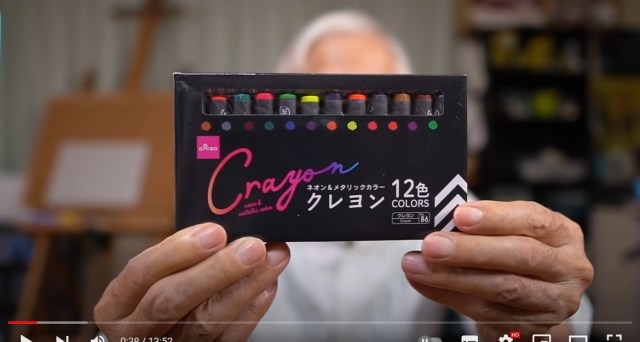
“Let’s overcome these barriers” says Shibasaki, who just might be everyone’s kind and cool Japanese art uncle.
They say it’s a poor craftsman who blames his tools, but what if you’re a poor artist in the sense that you simply don’t have a lot of money to spend on art supplies? You might find yourself searching for the least expensive pigments you can find, and that search might lead you to Daiso, Japan’s largest 100 yen store chain.
Daiso, as we’re all aware by now, sells everything, and sure enough, you can find crayons there. What’s more, they offer a pretty fancy-looking box of 12 metallic and fluorescent colors, all for their standard price of just 100 yen (US$0.92). But while Daiso selling crayons was a forgone conclusion, the real question is whether you can make beautiful art with them, and here with an answer is Harumichi Shibasaki.
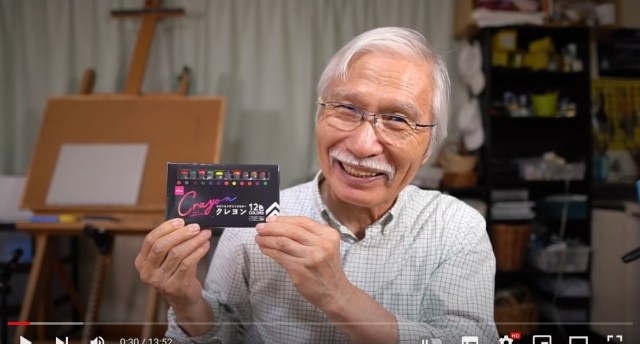
Shibasaki may not be someone you’re familiar with, but his YouTube channel, Watercolor by Shibasaki, will instantly make you feel welcome. A veteran art instructor with a career spanning more than 40 years, Shibasaki has a warm, soft-spoken personality, and watching his videos you might find yourself wondering if the artist is actually a kind-hearted, laid-back Japanese uncle you never knew you had.
In the video below (which has English subtitles that can be turned on in the settings), Shibasaki sets out to create a picture using the Daiso crayons. He doesn’t say what he’s going to draw, asking you to see if you can guess before it’s finished, but at the very start he drops the hints that it’s a large animal native to Africa.
Shibasaki recognizes that using metallic and neon colors to paint wildlife is an unusual choice, and the way he goes about the process is surprising too. After a few quick body outlines, he starts working his way through the fluorescent colors one by one, adding wide patches of hue to test their appearance and the crayons’ feel. None of this is going to be cut out or wasted though; it’s all going to be part of the final picture.
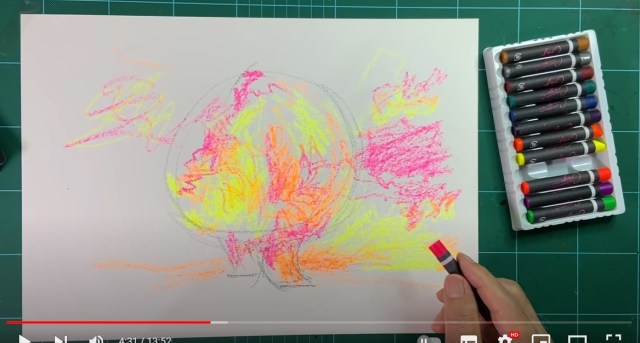
He quickly finds out that there are some compromises that come with such budget-friendly supplies. The crayons leave behind a lot of powdery particles that need to be periodically swept off the paper, and in some cases don’t lay down as much color as he’d expect for a stroke, although the problems can be alleviated by pressing down more forcefully when drawing. Shibasaki’s strongest praise for the fluorescents are for the yellow and green crayons, with the latter, he says, really helping to bring out more of the lackluster red crayon’s color through the contrast it creates.
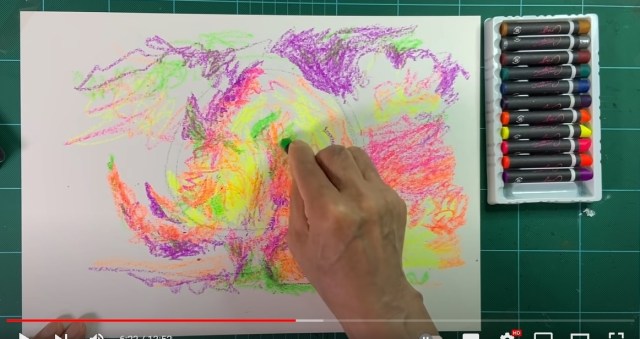
The metallic crayons don’t fare as well, though. Shibasaki’s intent was to use them for drawing the animal’s body, but they aren’t leaving quite enough color on the paper to add the details he wants, leading him to wonder if they lack a sufficient amount of base pigment. So to finish off the piece, Shibasaki switches over to some pricier Pentel crayons, whose fluorescents also make for smoother layering than the Daiso ones.
In the end, Shibasaki’s African animal comes out incredibly well, and his decision to combine fluorescent colors and wildlife has a soothing retro vibe, like something you might see hanging on a cafe wall in 1987.
As for his thoughts on the Daiso crayons? He’s got mixed feelings, saying “The fluorescent colors are pretty good! But the metallic effect I was expecting didn’t show at all. The fluorescent effects are lots of fun and great.” That doesn’t mean he regrets using them, though, and during the video he muses “But I feel more driven when facing such difficulties. Let’s overcome these barriers.”
So they may not be professional-grade, but if you’re of the mind that art is supposed to be fun, you should be able to get some artistic fun out of Daiso’s crayons (just remember that having fun with Daiso’s Light Up Poop Stick is still prohibited).
Related: Watercolor by Shibasaki YouTube channel
Source: YouTube/Watercolor by Shibasaki via Hachima Kiko
Images: YouTube/Watercolor by Shibasaki
● Want to hear about SoraNews24’s latest articles as soon as they’re published? Follow us on Facebook and Twitter!

 A visit to the largest Daiso 100 yen shop in all Japan【Photos】
A visit to the largest Daiso 100 yen shop in all Japan【Photos】 Often-overlooked castle in Japan looks so beautiful in the snow that we can’t take our eyes off it
Often-overlooked castle in Japan looks so beautiful in the snow that we can’t take our eyes off it Government study finds seniors active online more likely to feel life is worth living
Government study finds seniors active online more likely to feel life is worth living Daiso has giant new branch in middle of Tokyo’s Shinjuku neighborhood (and another beneath it)
Daiso has giant new branch in middle of Tokyo’s Shinjuku neighborhood (and another beneath it) Daiso will help you warp your reflection with a psychedelic infinity mirror for under five bucks!
Daiso will help you warp your reflection with a psychedelic infinity mirror for under five bucks! The My Melody ♡ Kuromi Anniversary Party is in full kawaii swing at the Ikebukuro Parco store
The My Melody ♡ Kuromi Anniversary Party is in full kawaii swing at the Ikebukuro Parco store Switch 2 announced by Nintendo, wisely switches up very little【Video】
Switch 2 announced by Nintendo, wisely switches up very little【Video】 One of Japan’s craziest stores filled a swimming pool with used CDs【Photos】
One of Japan’s craziest stores filled a swimming pool with used CDs【Photos】 Tokyo governor wants to start study abroad grant system, includes monthly activity allowance
Tokyo governor wants to start study abroad grant system, includes monthly activity allowance Japanese onsen hot spring comes with 99 types of soy sauce for visitors
Japanese onsen hot spring comes with 99 types of soy sauce for visitors Tough times for Japanese pubs as izakaya bankruptcies come at highest rate in more than a decade
Tough times for Japanese pubs as izakaya bankruptcies come at highest rate in more than a decade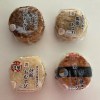 Should you warm up your convenience store onigiri rice balls in the microwave?【Taste test】
Should you warm up your convenience store onigiri rice balls in the microwave?【Taste test】 Nine reasons some Japanese women *only* date foreign guys
Nine reasons some Japanese women *only* date foreign guys Warm, sweet gingery bubbles in a can: Our review of “Hot Ginger Ale”
Warm, sweet gingery bubbles in a can: Our review of “Hot Ginger Ale” New Tokyo vending machine has nothing but apple juice, but all different kinds from Japan’s north
New Tokyo vending machine has nothing but apple juice, but all different kinds from Japan’s north Anime Industry Report shows overseas anime market is bigger than Japanese one, but is this a cultural tipping point?
Anime Industry Report shows overseas anime market is bigger than Japanese one, but is this a cultural tipping point? “I overdid it.” – Man in Japan fired after ditching work 633 times to go to the gym
“I overdid it.” – Man in Japan fired after ditching work 633 times to go to the gym Super-detailed cherry blossom forecast maps for 2025 show warm winter doesn’t mean early sakura
Super-detailed cherry blossom forecast maps for 2025 show warm winter doesn’t mean early sakura Starbucks Japan reveals new Valentine’s Day goods for 2025
Starbucks Japan reveals new Valentine’s Day goods for 2025 Overseas Uber driver and anime fan gets the Cowboy Bebop surprise of a lifetime【Video】
Overseas Uber driver and anime fan gets the Cowboy Bebop surprise of a lifetime【Video】 Kyoto reportedly planning to raise hotel guest taxes, create highest accommodation tax in Japan
Kyoto reportedly planning to raise hotel guest taxes, create highest accommodation tax in Japan What’s in the KFC Japan fukubukuro lucky bag?
What’s in the KFC Japan fukubukuro lucky bag? Nintendo and Godiva team up for fancy fun chocolate line【Photos】
Nintendo and Godiva team up for fancy fun chocolate line【Photos】 Japan’s deadliest food claims more victims, but why do people keep eating it for New Year’s?
Japan’s deadliest food claims more victims, but why do people keep eating it for New Year’s? The top 10 annoying foreign tourist behaviors on trains, as chosen by Japanese people【Survey】
The top 10 annoying foreign tourist behaviors on trains, as chosen by Japanese people【Survey】 Bear breaks into house in Japan, quickly begins spending winter exactly like Japanese people do
Bear breaks into house in Japan, quickly begins spending winter exactly like Japanese people do Hayao Miyazaki says Happy New Year to Studio Ghibli fans with new art for Year of the Snake
Hayao Miyazaki says Happy New Year to Studio Ghibli fans with new art for Year of the Snake This downtown Tokyo cafe is like a time machine that takes you back 50 years into the past
This downtown Tokyo cafe is like a time machine that takes you back 50 years into the past McDonald’s Japan has a fukubukuro lucky bag that everyone wants to get their hands on
McDonald’s Japan has a fukubukuro lucky bag that everyone wants to get their hands on What’s in Starbucks Japan’s fukubukuro lucky bag for 2025?
What’s in Starbucks Japan’s fukubukuro lucky bag for 2025? Station of despair: What to do if you get stuck at the end of Tokyo’s Chuo Rapid Line
Station of despair: What to do if you get stuck at the end of Tokyo’s Chuo Rapid Line McDonald’s new Happy Meals offer up cute and practical Sanrio lifestyle goods
McDonald’s new Happy Meals offer up cute and practical Sanrio lifestyle goods Foreign tourists on Shinkansen bullet train break suitcase etiquette, angering local passengers
Foreign tourists on Shinkansen bullet train break suitcase etiquette, angering local passengers Possessing Harry Potter’s Sword of Godric Gryffindor is now illegal in Japan
Possessing Harry Potter’s Sword of Godric Gryffindor is now illegal in Japan [Deleted] Article written for April Fool’s Day 2018
[Deleted] Article written for April Fool’s Day 2018 Japanese government to make first change to romanization spelling rules since the 1950s
Japanese government to make first change to romanization spelling rules since the 1950s Foreigner’s request for help in Tokyo makes us sad for the state of society
Foreigner’s request for help in Tokyo makes us sad for the state of society Japanese convenience store Family Mart announces abolishment of eat-in spaces
Japanese convenience store Family Mart announces abolishment of eat-in spaces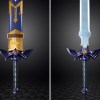 Life-size vibrating Legend of Zelda Master Sword for sale from Nintendo【Photos】
Life-size vibrating Legend of Zelda Master Sword for sale from Nintendo【Photos】 Princesses, fruits, and blacksmiths: Study reveals the 30 most unusual family names in Japan
Princesses, fruits, and blacksmiths: Study reveals the 30 most unusual family names in Japan Seiji cosplays as the hot new mascot Myaku-Myaku using only 100-yen products
Seiji cosplays as the hot new mascot Myaku-Myaku using only 100-yen products Taking Amazon Japan’s lowest-rated light-up nunchucks out for a spin
Taking Amazon Japan’s lowest-rated light-up nunchucks out for a spin We test Daiso’s new storage container to see if it keeps rice fluffy even after freezing
We test Daiso’s new storage container to see if it keeps rice fluffy even after freezing 100 yen store chain Daiso opens online shop with 30,000 items to choose from!
100 yen store chain Daiso opens online shop with 30,000 items to choose from! Daiso sells “emergency shelters,” and they have an amazing visual trick【Photos】
Daiso sells “emergency shelters,” and they have an amazing visual trick【Photos】 How to make an awesome Japanese summer dessert using only things you can buy at Daiso【SoraKitchen】
How to make an awesome Japanese summer dessert using only things you can buy at Daiso【SoraKitchen】 Is Daiso’s 500-yen grilling plate good enough for at-home yakiniku dinners? We find out!
Is Daiso’s 500-yen grilling plate good enough for at-home yakiniku dinners? We find out! What to buy at Daiso’s new Standard Products store in Tokyo
What to buy at Daiso’s new Standard Products store in Tokyo Our reporter buys a tiny kiddie pool from Daiso, has entirely too much fun with it
Our reporter buys a tiny kiddie pool from Daiso, has entirely too much fun with it Ghibli, Star Wars, Breaking Bad: artist carves crayons into amazing characters
Ghibli, Star Wars, Breaking Bad: artist carves crayons into amazing characters Head of Japan’s most successful 100-yen chain calls himself “hopeless,” might need a hug
Head of Japan’s most successful 100-yen chain calls himself “hopeless,” might need a hug Daiso releases shoulder bag series for every prefecture in Japan with surprising trivia facts
Daiso releases shoulder bag series for every prefecture in Japan with surprising trivia facts What’s the best spoon for Japanese curry?【Photos】
What’s the best spoon for Japanese curry?【Photos】 3 things to consider before buying Daiso’s Light Up Poop Stick
3 things to consider before buying Daiso’s Light Up Poop Stick Daiso’s Standard Products store — what’s worth buying and what’s not? Our expert weighs in
Daiso’s Standard Products store — what’s worth buying and what’s not? Our expert weighs in
Leave a Reply